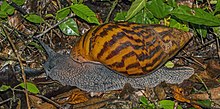Achatina achatina, commonly known as the giant African snail, also known as the giant tiger land snail, and gigantocochlea[citation needed] , is a species of large, air-breathing land snail, a terrestrial pulmonate gastropod mollusk in the family Achatinidae. The name "Achatina" is from "achates", Greek for agate.[1] It shares the common name "giant African snail" with other species of snails such as Lissachatina fulica and Archachatina marginata.
| Achatina achatina | |
|---|---|

| |
| Kakum National Park, Ghana | |
| Scientific classification | |
| Domain: | Eukaryota |
| Kingdom: | Animalia |
| Phylum: | Mollusca |
| Class: | Gastropoda |
| Subclass: | Heterobranchia |
| Order: | Stylommatophora |
| Suborder: | Achatinina |
| Superfamily: | Achatinoidea |
| Family: | Achatinidae |
| Genus: | Achatina |
| Species: | A. achatina
|
| Binomial name | |
| Achatina achatina (Linnaeus, 1758)
| |
| Synonyms | |
| |
Subspecies edit
- Achatina achatina achatina (Linnaeus, 1758)
- Achatina achatina bayoli Morelet, 1888
- Achatina achatina depravata Bequaert, 1950
- Achatina achatina elegans (Link, 1807)
- Achatina achatina monochromatica Pilsbry, 1904
- Achatina achatina roseolabiata Bequaert, 1950
- Achatina achatina togoensis Bequaert & Clench, 1934
Distribution edit
The species is believed to be native to West Africa, within 160 kilometres (99 mi) to 300 kilometres (190 mi) of the coasts off Sierra Leone, Liberia, Ivory Coast, Togo, Benin, Ghana, and Nigeria.
Achatina achatina is routinely confiscated by quarantine authorities at United States airports, especially in Baltimore, Dulles International Airport in Washington, D.C., John F. Kennedy International Airport in New York, and San Francisco.[2] These large snails are kept as pets in the Western world, where owners prize their large size, distinctive markings, and rarity.[3]
It has been suggested that these species be given top national quarantine significance in the United States.[4]
Description edit
The shells of these snails often grow to a length of 18 centimetres (7.1 in) with a diameter of 9 centimetres (3.5 in). Certain examples have been surveyed in the wild at 30×15 cm, making them the largest extant land snail species known.[5][6]
Similar to other giant land snails such as the Achatina fulica, Achatina achatinas are herbivores. Their diets consist of many plants such as nuts, flowers, fruit, stems, and leaves. Achatina achatina have also been known to eat farmers' crops including cocoa, peanuts, bananas, and cauliflower.[7]
In other instances, the giant African land snail has been known to eat smaller invertebrates in order to reach their desired calcium and protein intake needed for survival. Such insects include ants, small worms, beetles, and smaller snails.
Ecology edit
Like almost all pulmonate gastropods, these snails are hermaphrodites, having male and female sex organs. Each snail lays up to 1200 eggs per year. Achatina achatina is an important source of animal protein for West African forest-dwelling ethnic groups, and there is potential for commercial farming.[8]
This species' substantial size and potential for rapid population growth can make the snail a serious pest when introduced to non-native ecosystems. The population size of this species can be curtailed through disease caused by the bacterium Aeromonas hydrophila[9] but it often has no other natural enemies.[10]
References edit
- ^ "arnobrosi.com". arnobrosi.com. Archived from the original on 12 March 2012. Retrieved 26 September 2017.
- ^ "Achatina achatina" (PDF). USDA Animal and Plant Health Inspection Service. Archived from the original (PDF) on 8 July 2010.
- ^ "Achatina achatina". PetSnails.co.uk. 2005. Archived from the original on 13 November 2007. Retrieved 7 November 2007.
- ^ Cowie, R. H.; Dillon, R. T.; Robinson, D. G.; Smith, J. W. (2009). "Alien non-marine snails and slugs of priority quarantine importance in the United States: A preliminary risk assessment" (PDF). American Malacological Bulletin. 27 (1–2): 113–132. doi:10.4003/006.027.0210. S2CID 54919881. Archived from the original (PDF) on 16 June 2016.
- ^ Woodward, Samuel Peckworth (1868). Manual of the Mollusca: A Treatise on Recent and Fossil Shells. Virtue& Company. p. 97.
- ^ Institute for Scientific Co-operation (1988). Animal Research and Development. Institute for Scientific Co-operation. p. 68. ISSN 0340-3165. Archived from the original on 3 June 2016.
- ^ "Giant African Land Snail - Snail Facts and Information". Retrieved 10 April 2020.
- ^ Hodasi, J. K. M. (1979). "LIFE-HISTORY STUDIES OF ACHATINA (ACHATINA) ACHATINA (LINNÉ)". Journal of Molluscan Studies. 45 (3): 328–339. Archived from the original on 13 July 2012.
- ^ Dean, W. W.; Mead, A. R.; Northey, W. T. (1970). "Aeromonas liquefaciens in the giant African snail, Achatina fulica". Journal of Invertebrate Pathology. 16 (3). Elsevier: 346–351. doi:10.1016/0022-2011(70)90150-3. PMID 5501200.
- ^ Institut für Wissenschaftliche Zusammenarbeit mit Hochschulen der Entwicklungsländer (Tübingen, Germany) (1988). Animal Research and Development. Vol. 27–31. Institute for Scientific Co-operation. p. 70. ISSN 0340-3165. LCCN 76647555. Archived from the original on 3 June 2016. Snippet of page 70 Archived 22 May 2016 at the Wayback Machine
External links edit
- http://hawaii.gov/health/environmental/sanitation/sanitationguidelines/ratlungworm%20bulletin.pdf
- Media related to Achatina achatina at Wikimedia Commons